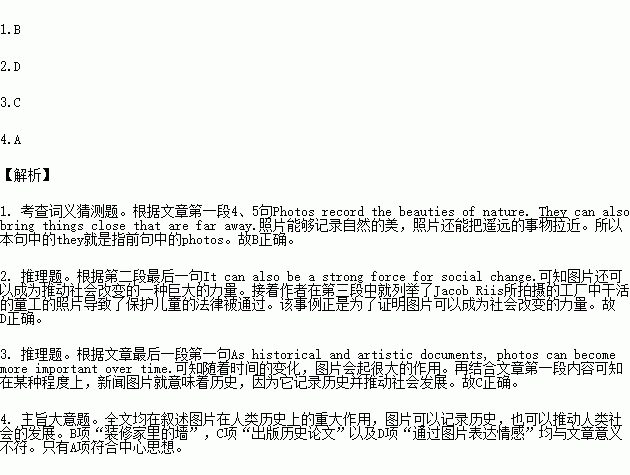题目内容
Photographs are everywhere. They decorate the walls of homes and are used in stores for sales of different goods. The news is filled with pictures of fires, floods, and special events. Photos record the beauties of nature. They can also bring things close that are far away. Through photos, people can see wild animals, cities in foreign lands, and even the stars in outer space. Photos also tell stories.
the stars in outer space. Photos also tell stories.
Reporting the news through photos is called photojournalism. At times photojournalists tell their stories through a single picture. At other times, they use a group of pictures to tell a story.  Each picture is like a chapter in a book, which can do more than record the facts. It can also be a strong force for social change.
Each picture is like a chapter in a book, which can do more than record the facts. It can also be a strong force for social change.
Jacob Riis was among the first photojournalists. He took pictures of parts of New York City where the poor lived. Riis believed that poverty caused crime, and he used photos to help him prove his point. A few years later, the photos of small children working in factories by Lewis Hine shocked the public. Hine’s pictures helped bring about laws to protect such children.
Hundreds of pictures may have to be taken in order to get one or two really good photos. It takes science to have the photo come out clearly and art to make a photo that has a good design and expresses feeling. Photojournalists make an actual record of what they see. A photo, however, can be both a work of art and an actual record. It can record an important event as a beautiful or exciting picture.
As historical and artistic documents, photos can become more important over time. Today photojournalists still have their pictures appear in newspapers and magazines. They also publish(发表) them in books and on the Internet.
1.The underlined word “They” in the first paragraph refers to .
A. beauties B. photos
C. goods D. events
2.The photos of the small children by Hine show us that photos .
A. are also works of art
B. are popular ways of reporting news
C. often shock the public
D. can serve as a force for social change
3.What can we learn from the passage?
A. News with pictures is encouraging
B. Photos help people improve.
C. News photos mean history in a sense.
D. People prefer reading news with pictures.
4.The text is mainly about .
A. telling the story through pictures
B. decorating the walls of homes
C. publishing historical papers
D. expressing feeling through pictures


 ney.
ney. gers onto the platform.
gers onto the platform.  in trip when I was ten years old. I went with my elder sister to visit our cousins six hundred miles away. The train--so loud and violent on the outside--was and rocking inside. We were very excited, and as that was also our first time away from our parents, we felt somewhat frightened too. However, because I had so much, I was a little disappointed when I was finally one of the passengers I had for so long.
in trip when I was ten years old. I went with my elder sister to visit our cousins six hundred miles away. The train--so loud and violent on the outside--was and rocking inside. We were very excited, and as that was also our first time away from our parents, we felt somewhat frightened too. However, because I had so much, I was a little disappointed when I was finally one of the passengers I had for so long. irplane.
irplane. money
money C. noisier D. faster
C. noisier D. faster